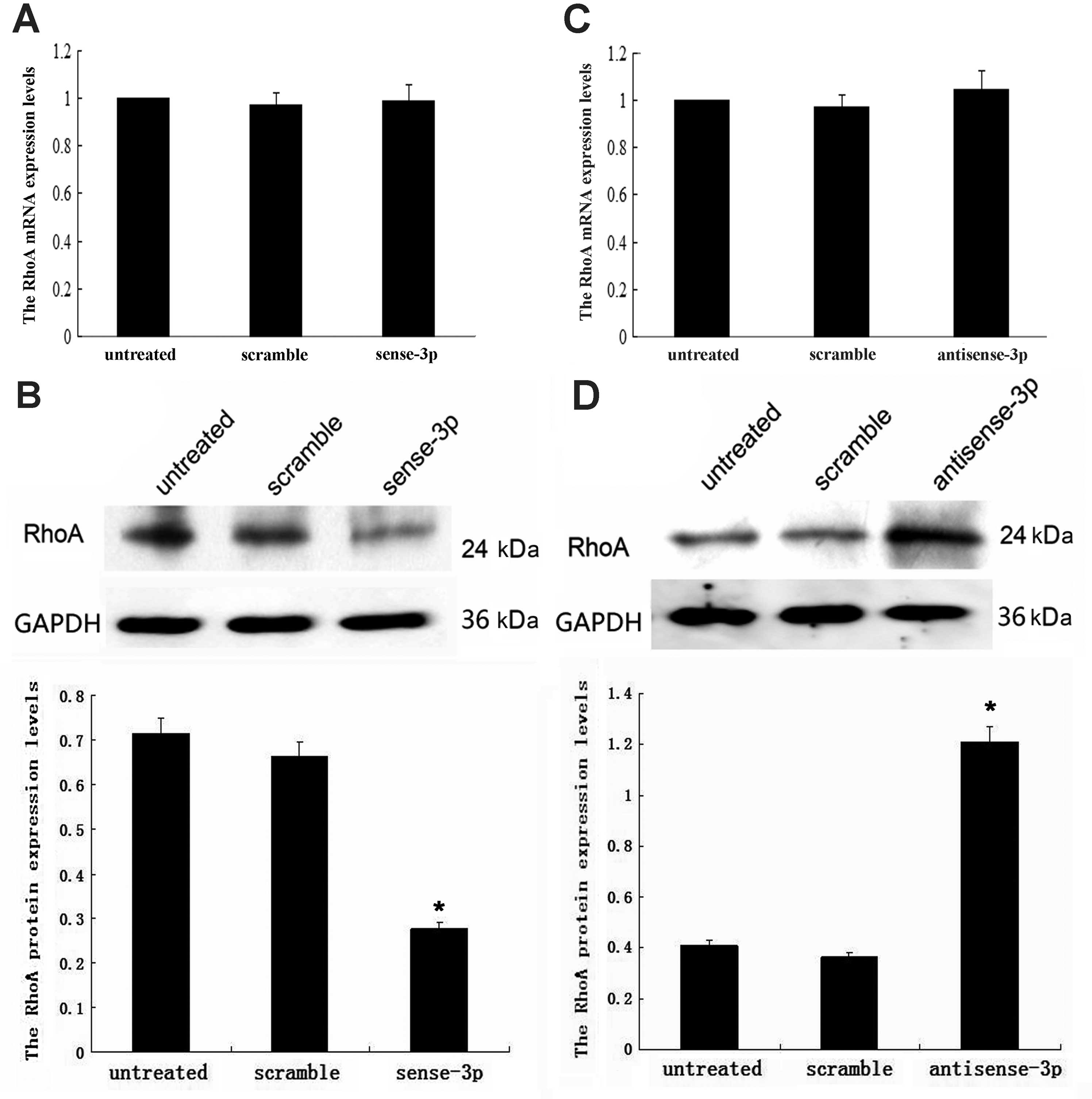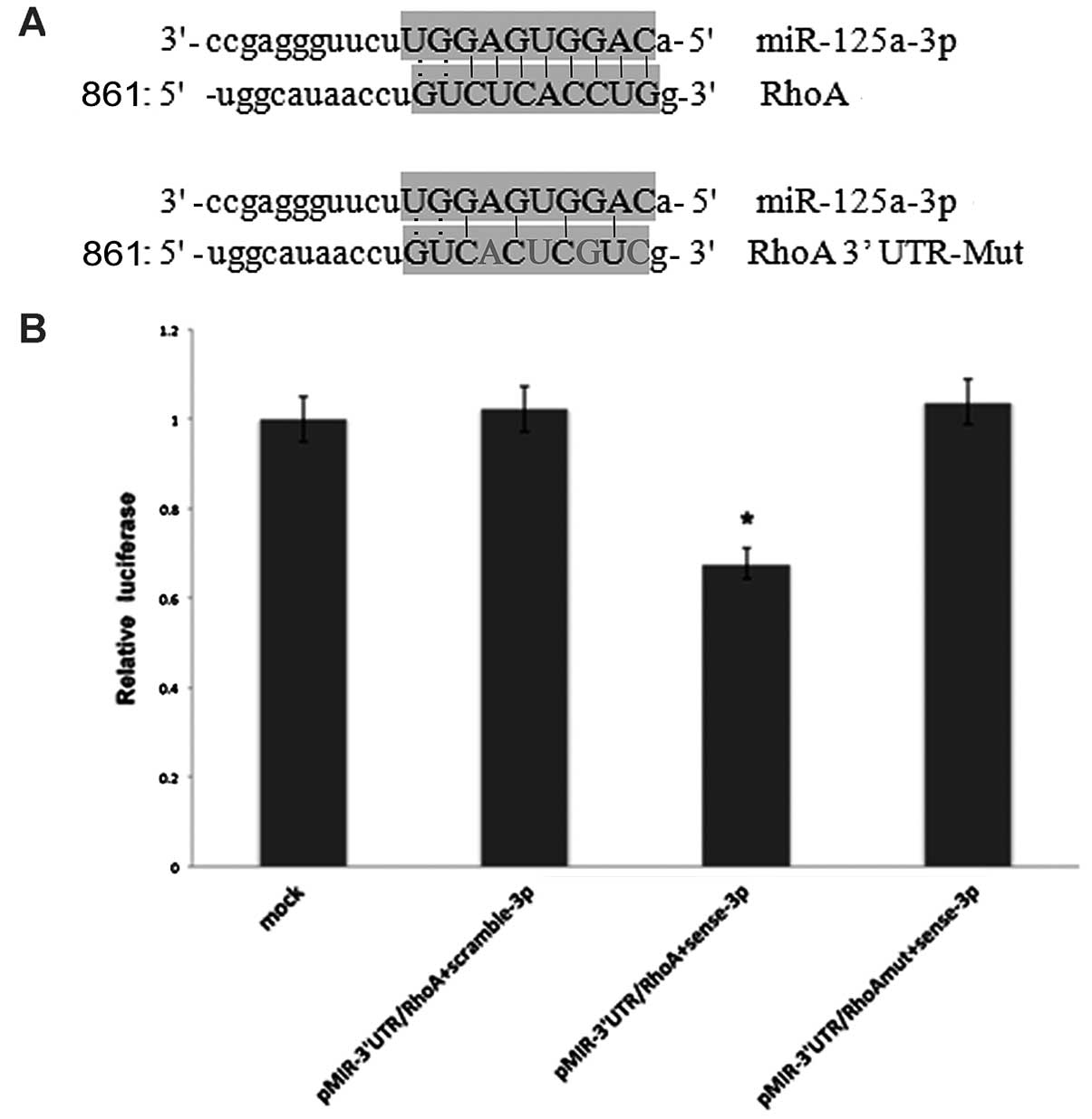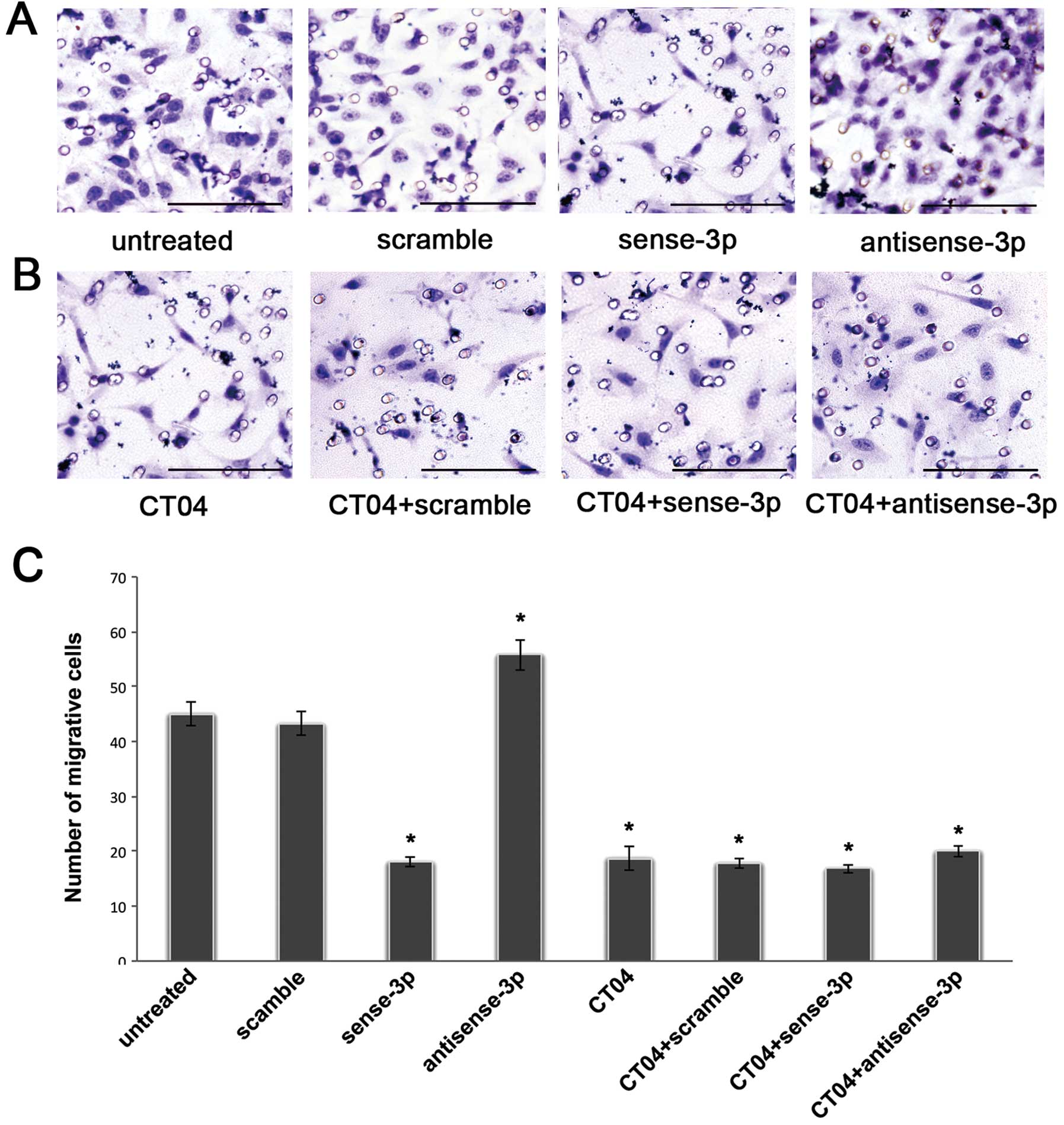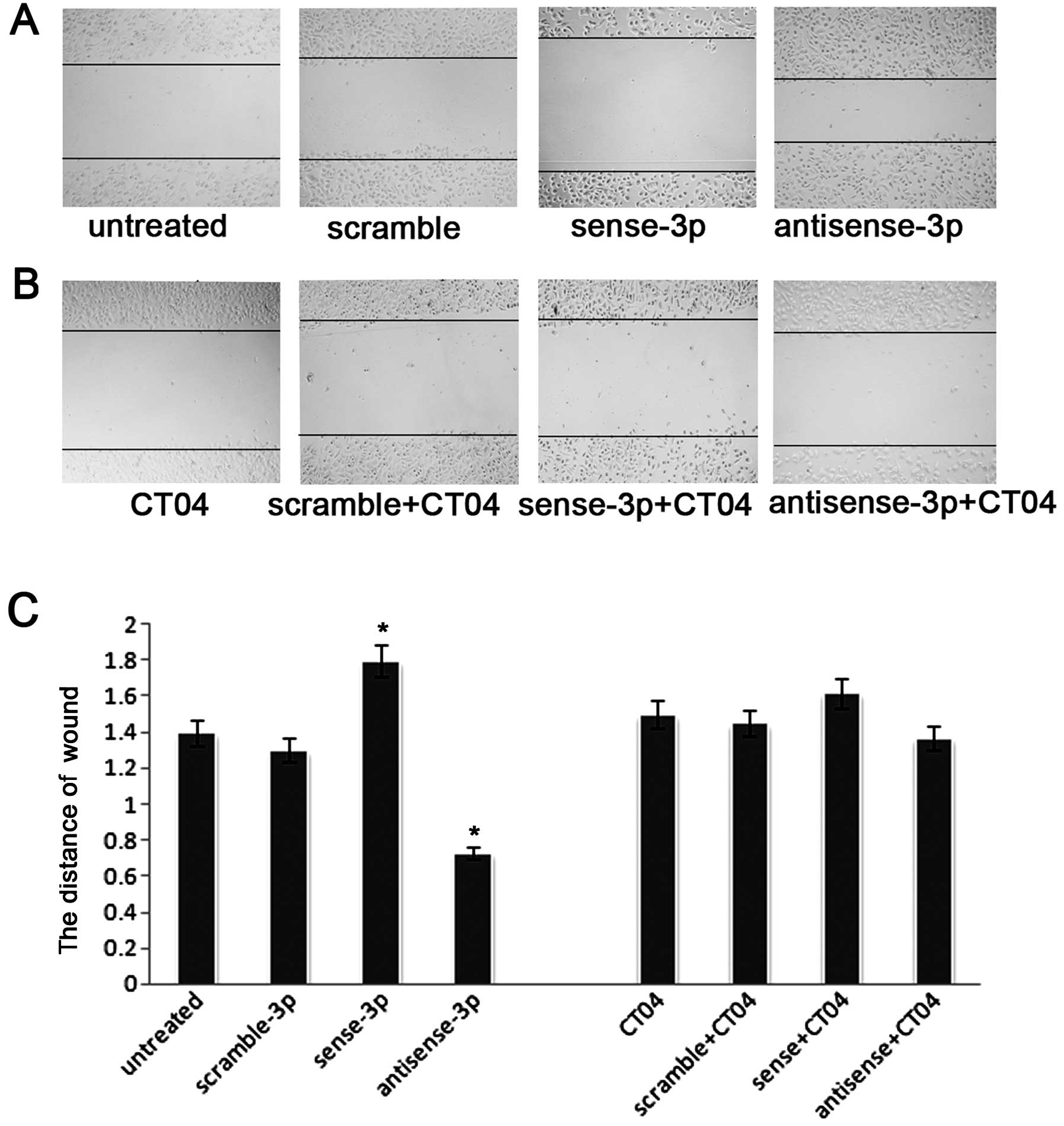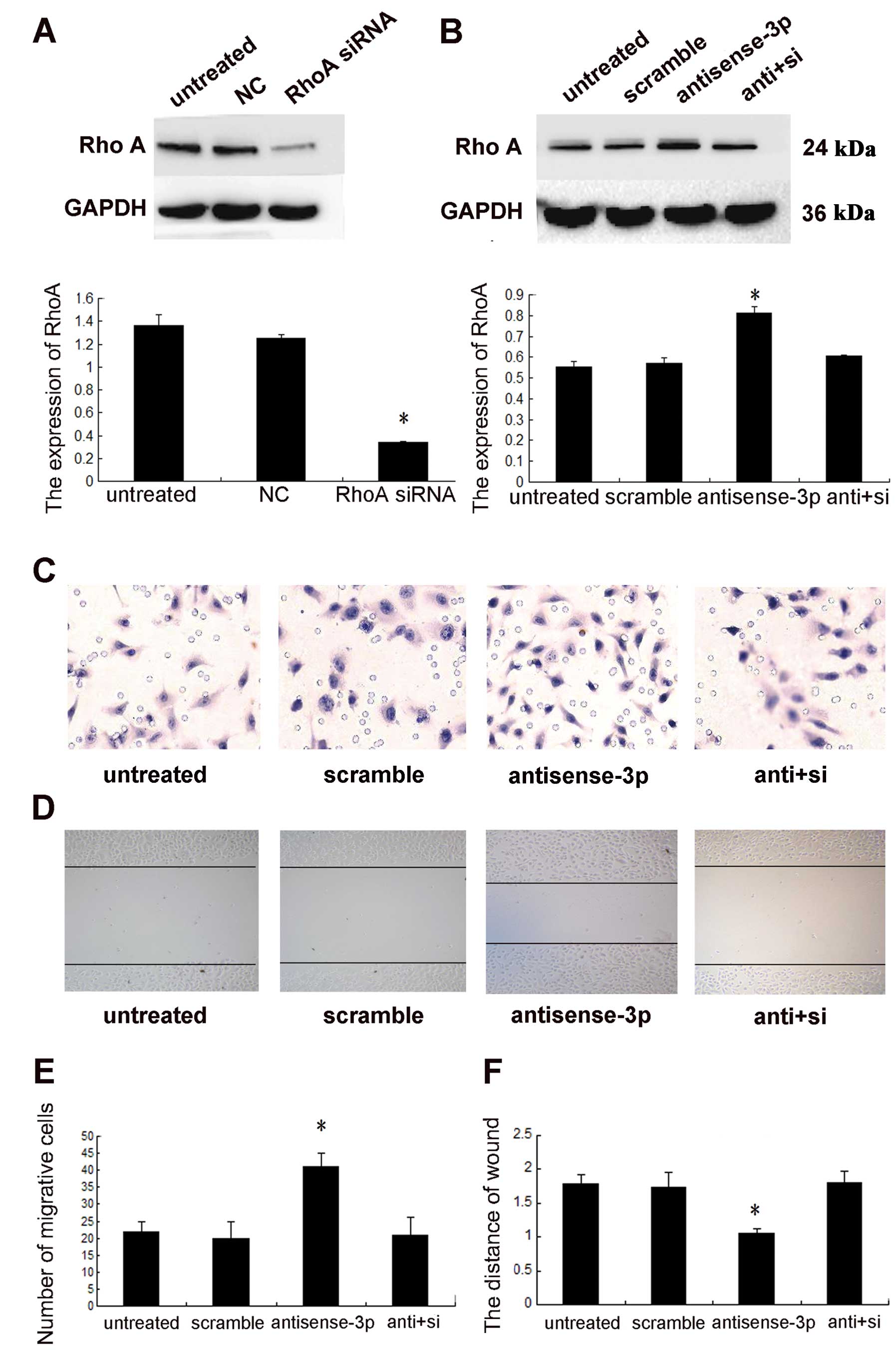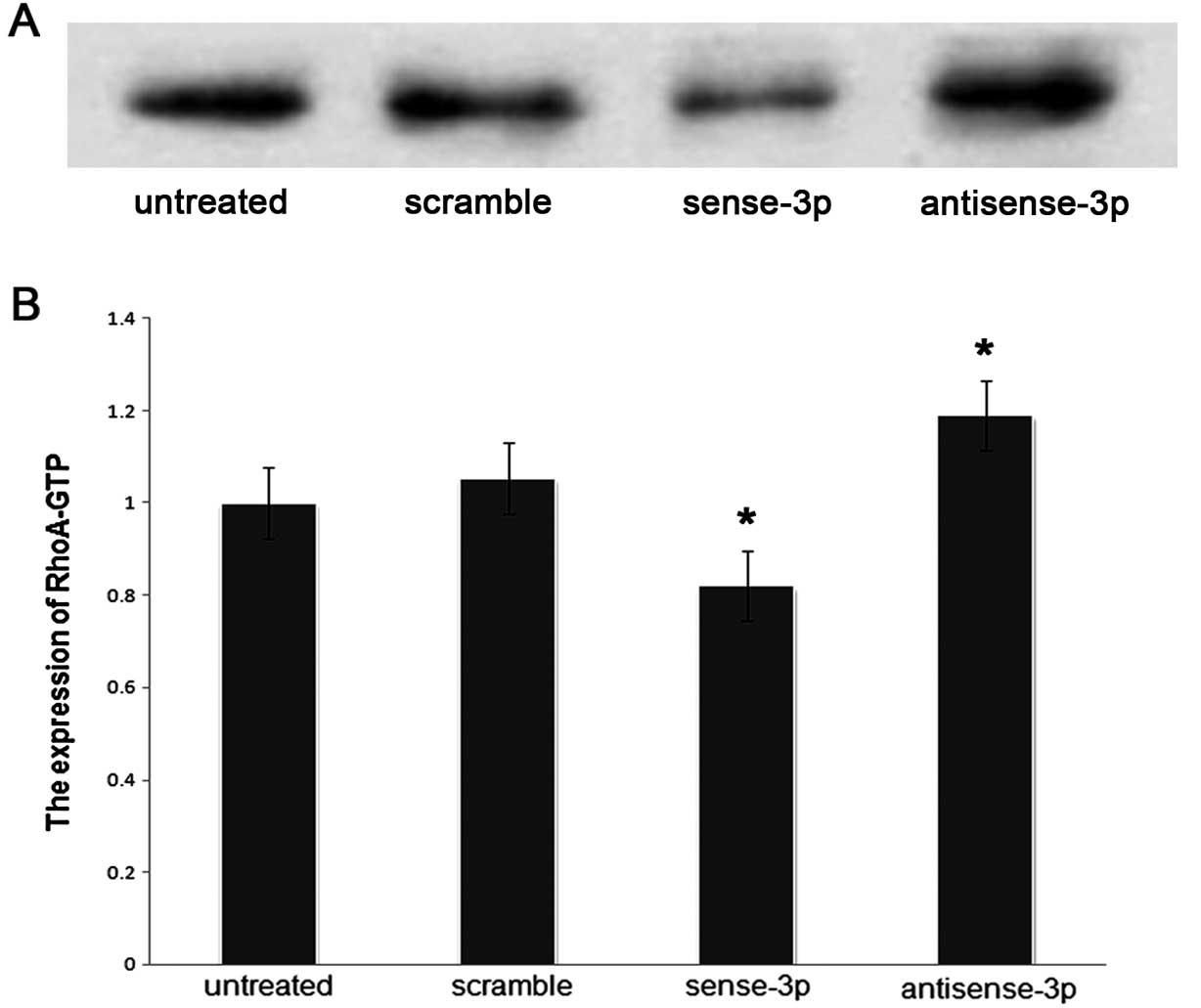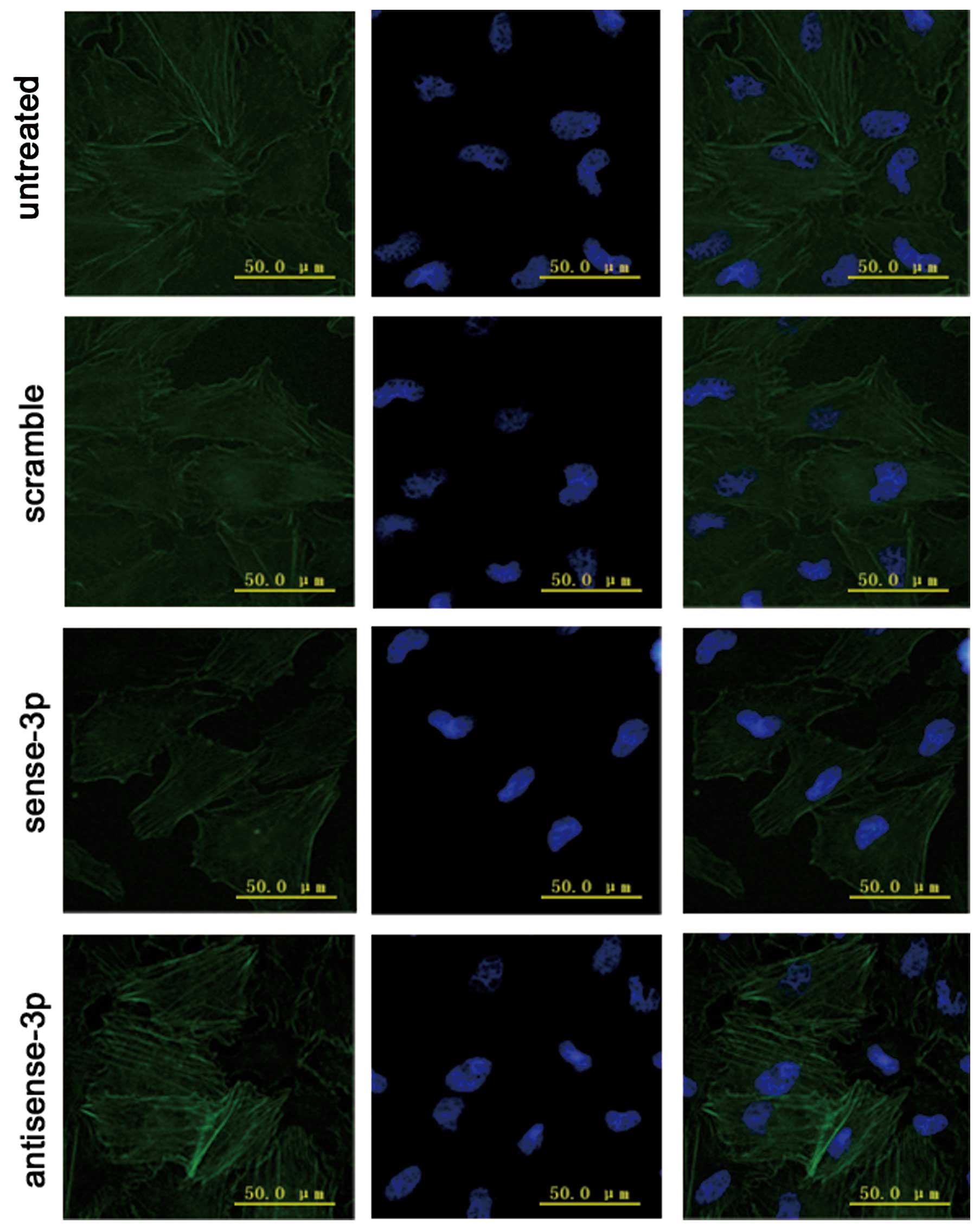MiRNA-125a-3p is a negative regulator of the RhoA-actomyosin pathway in A549 cells
- Authors:
- Published online on: March 21, 2013 https://doi.org/10.3892/ijo.2013.1861
- Pages: 1734-1742
Abstract
Introduction
Most patients with malignant tumors do not die of the primary neoplasia, but of secondary tumors known as metastases. As early as 1996, Sporn reported that more than 90% of cancer deaths resulted from the development of metastatic lesions (1). Metastasis depends upon the processes of tumor cell migration and invasion. Today, the molecular and cellular fundamentals of migration and invasion are recognized as complex multistep biological processes, most probably regulated by distinct genes and signaling pathways at every step. The various cytoplasmic proteins and transcription factors mediating these processes have already been identified (2). It was recently discovered that miRNAs can affect a wide range of biological functions, including tumor cell invasion and metastasis (3–7). MiRNAs are small, endogenous, non-protein-coding single-stranded RNAs of 20–25 nucleotides that post-transcriptionally regulate the expression of hundreds of target genes. MiRNAs bind target mRNA sequences through canonical base pairing between the seed sequence, which includes nucleotides 2–8 from the 5′-end, and the complementary sequence found in the 3′UTR of its target mRNA (8). In mammals, mature miRNAs are integrated into an RNA-induced silencing complex, which can suppress translation and occasionally also induce degradation of a targeted mRNA. MiRNAs are primarily negative gene regulators of post-transcriptional repression, and targets include tumor suppressors and oncogenes. For example, miR-21 was found to be highly expressed in colorectal cancers, and induced metastasis and invasion by inhibiting the tumor suppressor gene PDCD4 in colorectal cancer cells (9). Thus, as an oncogene, miR-21 exhibited regulatory effects. However, when expressed at lower levels in tumors, miRNAs have also demonstrated tumor suppressor functions. For example, the action of let-7 miRNA as an antioncogene was found to be absent in lung cancers by inhibiting downstream translation of MYC (10).
MiR-125a has been reported to control the differentiation of the embryonic cancer cell line P19 by negatively regulating the 3′UTR of lin-28 mRNA (11). It was found to inhibit translation of the target gene t-trkC and thereby modulating proliferation of neuroblastomas (12). In addition, during the process of epithelial-mesenchymal transdifferentiation (EMT) in ovarian cancer, miR-125a was found to negatively regulate the target gene ARID3B and inhibit EMT (13).
MiR-125a-3p, a member of the miR-125a family, is derived from the 3′-end of pre-miR-125a. However, there are few reports on the function of miR-125a-3p. Our research group has shown that miR-125a-3p is poorly expressed in non-small cell lung cancers (NSCLCs) (14). Real-time polymerase chain reaction (PCR) assays showed that miR-125a-3p expression was significantly decreased in NSCLCs compared to corresponding adjacent normal tissue. Therefore, we hypothesized that miR-125a-3p may act as a tumor suppressor by negatively regulating some oncogenes. Importantly, Spearman’s correlation tests demonstrated a negative relationship between miR-125a-3p expression, pathological tumor stage and lymph node metastasis. In addition, downregulation of levels of miR-125a-3p expression in A549 cells resulted in higher rates of invasion and migration. These previous results led us to hypothesize that miR-125a-3p may be involved in the migration and invasion of NSCLC tumor cells. To the best of our knowledge, there have not been any reports on the mechanisms involved in the regulation of migration and invasion by miR-125a-3p.
The metastatic sequence of primary tumor cells includes detachment, local migration and invasion of stromal tissue, intravasation and transit through blood vessels, capillary bed arrest and extravasation, further local crawling and invasion, attachment, formation of micrometastases, survival, perhaps dormancy and eventually additional proliferation (15,16). Cellular migration is an essential function of tumor cell invasion and metastasis. Accordingly, the purpose of this study was to explore how miR-125a-3p affects the migration of cells of the A549 lung cancer cell line.
Materials and methods
Cell culture
A549 cells were propagated in DMEM (Gibco, Carlsbad, CA, USA) supplemented with 10% fetal bovine serum (FBS), 100 U/ml penicillin and 100 U/ml streptomycin. The cells were incubated at 37°C in a 5% CO2 humidified atmosphere until 75% confluent.
Transfection
All transfections were carried out using Lipofectamine 2000 (Invitrogen, Carlsbad, CA, USA) according to the manufacturer’s instructions. The following 2′-O-methyl oligonucleotides were synthesized by Integrated DNA Technologies and purchased from Shanghai GeneChem: 2′-O-Me-sense-125a-3p: 5′-ACA GGU GAG GUU CUU GGG AGCC-3′, 2′-O-Me-antisense-125a-3p: 5′-GGC UCC CAA GAA CCU CAC CUGU-3′, and 2′-O-Me-scramble-125a-3p: 5′-GGU CGG UGC UCG AUG CAG GUAA-3′. Twenty-four hours prior to transfection, the cells were plated into 6-well plates for RNA extraction and into 10-cm dishes for protein extraction. A549 cells were transfected with 20 μM of 2′-O-methyl oligo-nucleotides, and RNA and protein were extracted 24 h after transfection. In addition, RhoA small interfering RNA (siRNA) or the negative control was used in co-transfection with or without antisense-125a-3p. The sequences of the RhoA siRNAs were: 5′-GAAGUCAAGCAUUUCUGUCTT-3′ (sense) and 5′-GACAGAAAUGCUUGACUUCTT-3′ (antisense) (17).
To block the function of RhoA, the Rho inhibitor CT04 (Cytoskeleton, Denver, CO, USA), was added to the culture medium at a final concentration of 2.0 μg/ml, as described previously (18). Migration was investigated in the presence of CT04 using a Transwell chamber as described in the following section.
Cell migration assay
A549 cells (5×104 cells/chamber) were trypsinized, washed, resuspended in serum-free DMEM, and placed in the top portion of the chamber. The lower portion of the chamber contained 10% FBS as a chemoattractant. The chambers were incubated at 37°C, 5% CO2 for 12 h, and then the cells remaining on the membrane were washed with PBS, fixed in 100% methanol, stained with haematoxylin, photographed and counted. Five random fields were selected randomly, then analyzed for each chamber. Each of 3 independent experiments was carried out in duplicate.
Luciferase assays
The plasmid used for these assays contained a full-length RhoA 3′UTR coupled to a luciferase reporter, and was a kind gift from Dr William Kong and Dr Jin Q. Cheng (H. Lee Moffitt Cancer Center and Research Institute, Tampa, FL, USA). The following primers were used to amplify the 3′UTR of the RhoA gene from human cDNA (NM_001664.2): forward primer 5′-GAC TAG TCA ATC TGG GTG CCT TGT CTTG-3′, reverse primer 5′-CCC AAG CTT GGG TGC CTT TAT TCT ATT AGT AGT TGG AAA-3′. The PCR fragment were digested and cloned into the pMIR-Report vector (Ambion) at the SpeI and HindIII sites. The mutant plasmid containing a full-length RhoA 3′UTR mutant coupled to a luciferase reporter was constructed by Sauer Biotechnology Inc. (China).
A549 cells were seeded onto 24-well plates the day prior to transfection. They were transfected with 0.4 μg of the luciferase expression construct, 20 μM 2′-O-methyl sense or scramble oligonucleotides, and 0.02 μg of the Renilla luciferase vector pRL-TK (Promega) for normalization. Mock transfected cells were transfected with the luciferase constructs alone. After 24 h, luciferase assays were performed using the Dual-Luciferase Reporter Assay System (Promega). Firefly luciferase activity was normalized to Renilla luciferase activity. All transfection experiments were conducted in triplicate.
RNA isolation and quantitative real-time polymerase chain reaction (qRT-PCR)
Total RNA was prepared using TRIzol (Invitrogen). RhoA cDNA was generated by PrimerScript RT reagent kit (Takara, Dalian, China) and amplified using RhoA primers with SYBR Premix EX Taq II (Takara). The primer sequences for RhoA were: 5′-CGA CAG CCC TGA TAG TTT A-3′ (forward) and 5′-GTG CTC ATC ATT CCG AAG A-3′ (reverse), and the primer sequences for β-actin were F: 5′-AGCACAGAGCCTCGCCTTTG-3′ (forward), R: 5′-ACATGCCGGAGCCGTTGT-3′ (reverse). The relative quantity of RhoA, normalized to β-actin, calculated based on the following equation RQ = 2−ΔΔCt.
Western blot analysis
Cells were washed twice with ice-cold phosphate-buffered saline (PBS) and lysed using the M-PER reagent (Pierce Biotechnology) containing 1 mM PMSF and phosphatase inhibitors for 1 h at 4°C. The supernatants were centrifuged at 12,000 × g for 30 min at 4°C, and collected for analysis. Aliquots of supernatant containing 80 μg of total protein were separated on 12 or 10% SDS-PAGE gels and transferred to PVDF membranes. The membranes were blocked using 5% fat-free milk, and incubated with mouse anti-RhoA (1:200, Santa Cruz Biotechnology, Santa Cruz, CA, USA), or mouse anti-GAPDH (1:1,000, Santa Cruz Biotechnology). Membranes were incubated at 4°C overnight and incubated with corresponding secondary antibodies (1:4,000, Chemicon, Temecula, CA, USA) at room temperature for 1 h. Immunoreactive bands were identified using Super ECL reagent (Pierce Biotechnology), according to the manufacturer’s protocol. Specific bands for RhoA, F-actin and GAPDH were identified using prestained protein molecular weight markers (SM0441, MBI Fermentas). The ECL Imaging System (UVP Inc.) was used to visualize the specific bands and the optical density of each band was measured using Image J software.
Wound healing assay
When cell confluence was less than 90% at 48 h after transfection, wounds were created in confluent cells using a 200-ml pipette tip. The cells were then rinsed with medium to remove any free-floating cells and debris. Medium was then added, and culture plates were incubated at 37°C. Wound healing within the scrape line was observed at different time points, and representative scrape lines for each cell line were photographed. Duplicate wells for each condition were examined for each experiment, and each experiment was repeated 3 times. The optical the distance of wound were measured using Image J software.
Rho-GTP pull-down assay
The Rho-GTP pull-down assay was performed using an RhoA/Rac1/Cdc42 Activation Assay Combo Kit (STA-405, Cell Biolabs Inc., San Diego, CA, USA). Medium was aspirated off cells cultured to approximately 80 to 90% confluence, and the cells were rinsed twice with ice-cold PBS before being treated with ice-cold lysis buffer (0.5–1 ml per 100-mm tissue culture plate). The cell culture plates were subsequently placed on ice for 10–20 min. The cells were centrifugated at 14,000 × g for 10 min at 4°C, and then 20 μl of 0.5 M EDTA was added to each aliquot sample. The positive and negative controls received 10 μl of 100X GTPγS and 10 μl of 100X GDP, respectively. All tubes were incubated with agitation for 30 min at 30°C. Reactions were stopped using 65 μl of 1.0 M MgCl2. Rhotekin RBD or PAK PBD Agarose beads were added to the cell lysates and incubated for 1 h at 4°C. After centrifugation for 10 sec at 14,000 × g, the beads were washed with lysis buffer and Rho-GTP was eluted in Laemmli sample buffer. Antibody against RhoA was used to analyze eluted sample on western blots.
Immunofluorescence
When cell confluence was less than 5×105 cells at 48 h after transfection, cells were serum-starved for 4 h and fixed in 2% formaldehyde/PBS for 7 min at room temperature. After permeabilization with 0.1% Triton X-100 and blocking with 1.5% normal goat serum, the cells were stained with rhodamine-phalloidin for 30 min at 37°C to label F-actin, and mounted using Gelvatol mounting medium.
Statistical analysis
All data are presented as mean ± SD of 3 independent experiments. A p-value ≤0.05 was considered significant. All statistical analyses were performed using the SPSS13.0 software package.
Results
RhoA is a potential miR-125a-3p target gene
To study how miR-125a-3p might regulate migration, we first proceeded to identify potential targets known to play a role in cell mobility. Among the candidates surveyed previously (14), we found that the 3′UTR of the RhoA gene contains highly conserved regions that may serve as binding sites for miR-125a-3p, as determined at microrna.org (Fig. 1).
Effects of miR-125a-3p on RhoA expression
Since results of our previous study showed that miR-125a-3p expressed moderately in A549 NSCLC cells, we chose A549 cells for this study. To confirm whether suppression of migration by miR-125a-3p is associated with changes in RhoA expression, we measured the level of both RhoA mRNA and protein using qRT-PCR and western blot analysis in the presence of upregulation and downregulation of miR-125a-3p. Upregulation of miR-125a-3p was achieved using transfected sense-miR-125a-3p; while RhoA mRNA remained unchanged (p=0.309, Fig. 2A), the RhoA protein concentration decreased (p<0.001, Fig. 2B). Downregulation of miR-125a-3p was achieved using transfected antisense-miR-125a-3; while RhoA mRNA remained unchanged (p=0.942, Fig. 2C), the RhoA protein concentration increased (p<0.001, Fig. 2D). These results indicate that miR-125a-3p may post-transcriptionally regulate RhoA expression.
MiR-125a-3p directly regulates the expression of the target gene RhoA
To further demonstrate that RhoA is a potential target of miR-125a-3p, we generated luciferase reporters that contained the 3′UTR of the RhoA gene (Fig. 3A). Results from 3 independent experiments showed that reporter activity was reduced by the ectopic expression of miR-125a-3p (p<0.001, Fig. 3B). We also generated luciferase reporters that contained a mutated sequence within the predicted target sites of the 3′UTR of the RhoA gene (Fig. 3A) to further demonstrate the interaction between miR-125a-3p and the 3′UTR of RhoA. Data showed that reporter activity was not reduced by the ectopic expression of miR-125a-3p (Fig. 3B). Taken together, these results indicated that in A549 cells, the RhoA gene was a functional target of miR-125a-3p.
MiR-125a-3p inhibits migration via the Rho-dependent pathway
Previously we found that downregulation of miR-125a-3p induced increased migration of A549 cells in transwell experiments (14). Fig. 4A shows that the number of migrating cells decreased after transfection with sense miR-125a-3p. In contrast, the number of migrating cells increased after transfection with antisense miR-125a-3p. A similar trend was seen in the wound healing assays (Fig. 5A). To further validate whether miR-125a-3p inhibits migration in a Rho-dependent manner, we blocked RhoA activity using the Rho inhibitor CT04 at a final concentration of 2.0 μg/ml. The number of migrating cells was significantly decreased after treatment with CT04 compared with the untreated cells in a Transwell experiment without matrigel (p<0.001, Fig. 4B and C), and as seen in the wound healing assay (p<0.001, Fig. 5B and C). Moreover, after treatment with CT04, the migratory ability of A549 cells transfected with the antisense-miR-125a-3p or the sense miR-125a-3p was neither decreased nor increased (p<0.001, Figs. 4B, C, 5B and C). These results suggest that miR-125a-3p cannot regulate RhoA when the Rho pathway is blocked.
Downregulation of RhoA by the inhibitor CT04 may directly affect the function of RhoA, independent of the concentration of protein. To rule out this effect, siRNA was used for specific downregulation of the expression of RhoA to confirm that miR-125a-3p mediated NSCLC cell migration through RhoA. The knockdown efficacy was identified using western blot analysis (p<0.001, Fig. 6A). Knockdown of the expression of RhoA (p<0.001, Fig. 6B), abolished the effect of antisense-miR-125a-3p on cell migration (Fig. 6C and D).
Effects of RhoA expression on activated RhoA (RhoA-GTP) and intracellular actomyosin
We investigated whether RhoA expression affected the migration of A549 cells via organization of the actin cytoskeleton, and also affected the levels of RhoA-GTP. The levels of RhoA-GTP were quantified using a pull-down assay after transfecting A549 cells with sense-miR-125a-3p or antisense-miR-125a-3p. The results showed that the levels of RhoA-GTP were decreased (p<0.001, Fig. 7) along with decreased expression of RhoA when sense-miR-125a-3p was transfected. In addition immunofluorescence microscopy demonstrated that accumulative actin filaments were lower (Fig. 8). By contrast, the levels of RhoA-GTP increased (Fig. 7) with increase in RhoA expression when antisense-miR-125a-3p was transfected. Moreover, immunofluorescence microscopy results demonstrated that the accumulative actin filaments had grown (Fig. 8).
Discussion
MiRNAs negatively control downstream targeted genes to interfere with cell activities. Therefore, the functions of miRNAs are very important, especially with regard to their modulation of target genes. In this study, we first used bioinformatics to determine that RhoA is closely associated with cell migration and is a target gene regulated by miR-125a-3p. By manipulating miR-125a-3p expression levels in A549 NSCLC cells, we found that miR-125a-3p can post-transcriptionally regulate the expression of RhoA mRNA and repress expression of the RhoA protein. Luciferase reporter assays using reporter constructs containing the RhoA 3′UTR or specific mutated sites of RhoA 3′UTR indicated that miR-125a-3p directly targets the RhoA 3′UTR in A549 cells.
RhoA was the first identified member of the Rho family of GTPases (19). It shuttles between an inactive GDP-bound state and an active GTP-bound state and exhibits intrinsic GTPase activities, mainly involved in forming stress fibers and assembling focal adhesion complexes. Results of research using stable transfectants of active RhoA have demonstrated that the RhoA-actomyosin pathway plays a pivotal role in transmigration (20). RhoA regulates the signal transduction from cell surface receptors to intracellular target molecules and is involved in a variety of biological processes, including cell morphogenesis (21), motility (22), cytokinesis (23,24) and tumor progression (25,26). The inconsistency of the degree of RhoA transcription and levels of protein expression suggest that RhoA may be subject to post-transcriptional regulation by microRNAs. Fritz et al first detected the expression of Rho GTPases in human tumor tissues, including lung cancer. They proposed that RhoA may be overexpressed in certain tumors (27). RhoA has also been demonstrated to play an important role in tumor invasion and metastasis by its mediation of the cytoskeletal reorganization of key regulatory proteins. Results of our previous and current Transwell experiments suggest that miR-125a-3p directly targets RhoA, and may be involved in migration of NSCLC cells.
Thus, miR-125a-3p may act as an anti-oncogene by suppressing cell migration via the post-transcriptional repression of RhoA. To the best of our knowledge, this is the first study to demonstrate that miR-125a-3p impacts migration by regulating the 3′UTR of RhoA in human lung cancer A549 cells. After we blocked RhoA activity with the Rho inhibitor CT04, we found that miR-125a-3p could not regulate RhoA. In addition, the expression of RhoA was knocked down using siRNA. We found that downregulation of RhoA expression by siRNA significantly abrogated antisense-miR-125a-3p-induced cell migration. These results further validated the possibility that miR-125a-3p inhibited migration via a Rho-dependent pathway.
The effects of RhoA protein levels on activated RhoA have been reported. There is a report (28) that the stable RhoA transfectant of the ovarian cancer cell line SKOV3 resulted in overexpression of RhoA, which did not alter proliferative activity, but significantly increased invasiveness. The invasiveness was suppressed by the addition of a Rho inhibitor. A nude mouse model was used to show that the frequency of dissemination and the number of disseminated lesions were significantly increased in mice inoculated with RhoA transfectants compared tocontrol mice. The investigators also revealed that overexpression of RhoA mRNA and protein were associated with the spread of ovarian cancer, and believed that overexpression of RhoA had facilitated the accumulation of RhoA protein in the cell membrane and further to activate RhoA (28). A similar conclusion was also demonstrated from work using a rat liver cell model of MM1 (29). Overexpression of RhoA had also resulted in increased levels of activated RhoA, and further enhanced tumor cell motility.
The results of our study led us to conclusions similar to these earlier reports. Upregulated expression of miR-125a-3p negatively inhibited the expression of RhoA protein because of incomplete complementation to nucleotides within the 3′UTR of the target gene RhoA. At the same time, the level of RhoA-GTP decreased in A549 cells, along with decreasing accumulative actin filaments, as shown by immunofluorescence. Downregulation of miR-125a-3p expression led to increased levels of RhoA-GTP and increased expression of RhoA protein. In addition, accumulative actin filaments increased.
We suggest that in the lung cancer cell line A549, miR-125a-3p directly regulates the target gene RhoA by incomplete complementation with the 3′UTR, ultimately inhibiting the expression levels of the RhoA protein. The level of RhoA-GTP is directly correlated with the level of RhoA protein, as well as the accumulation of actin filaments in A549 cells, which affects cell motility. MiR-125a-3p may indirectly affect the level of RhoA-GTP by direct regulation of RhoA, and thereby controls the migration of cells.
In this study, we demonstrated that miR-125a-3p post-transcriptionally regulates the 3′-UTR of RhoA mRNA and inhibits expression of RhoA protein, which indirectly decreases the levels of RhoA-GTP. Furthermore, downregulation of miR-125a-3p led to increasing accumulation of actin filaments, ultimately leading to increased migratory capacity of A549 cells. It is likely that miR-125a-3p is involved in the RhoA-actomyosin pathway, which affects the migration of the lung cancer cell line A549.
Acknowledgements
We are very grateful to Dr William Kong and Dr Jin Q. Cheng for providing the plasmid containing the full-length RhoA 3′UTR used in this study. We are very grateful to Dr Baoshen Zhou from the Department of Epidemiology, School of Public Health, China Medical University for statistical analysis. We also thank Nan Liu for technical assistance, and the members of our lab for useful suggestions. This study was supported by grants from the National Natural Science Foundation of China (no. 30972967), Specialized Research Fund for the Doctoral Program of Higher Education (no. 20092104110018), Program for Liaoning Excellent Talents in University, Liaoning Provincial Natural Science Foundation (no. 20102122), and Shenyang Science and Technology Program (F10-149-9-41).
References
|
Sporn MB: The war on cancer. Lancet. 347:1377–1381. 1996. View Article : Google Scholar : PubMed/NCBI | |
|
Nguyen DX, Bos PD and Massague J: Metastasis: from dissemination to organ-specific colonization. Nat Rev Cancer. 9:274–284. 2009. View Article : Google Scholar : PubMed/NCBI | |
|
Crawford M, Brawner E, Batte K, et al: MicroRNA-126 inhibits invasion in non-small cell lung carcinoma cell lines. Biochem Biophys Res Commun. 373:607–612. 2008. View Article : Google Scholar : PubMed/NCBI | |
|
Xiong BH, Cheng Y, Ma L and Zhang CQ: Mir-21 regulates biological behavior through the PTEN/PI3K/AKT signaling pathway in human colorectal cancer cells. Int J Oncol. 42:219–228. 2013.PubMed/NCBI | |
|
Tavazoie SF, Alarcón C, Oskarsson T, et al: Endogenous human microRNAs that suppress breast cancer metastasis. Nature. 451:147–152. 2008. View Article : Google Scholar : PubMed/NCBI | |
|
Nicoloso MS, Spizzo R, Shimizu M, et al: MicroRNAs - the micro steering wheel of tumour metastases. Nat Rev Cancer. 9:293–302. 2009. View Article : Google Scholar : PubMed/NCBI | |
|
Valastyan S, Reinhardt F, Benaich N, et al: A pleiotropically acting microRNA, miR-31, inhibits breast cancer metastasis. Cell. 137:1032–1046. 2009. View Article : Google Scholar : PubMed/NCBI | |
|
Bartel DP: MicroRNAs: target recognition and regulatory functions. Cell. 136:215–233. 2009. View Article : Google Scholar : PubMed/NCBI | |
|
Asangani IA, Rasheed SA, Nikolova DA, et al: MicroRNA-21 (miR-21) post-transcriptionally downregulates tumor suppressor Pdcd4 and stimulates invasion, intravasation and metastasis in colorectal cancer. Oncogene. 27:2128–2136. 2008. View Article : Google Scholar : PubMed/NCBI | |
|
He XY, Chen JX and Zhang Z: The let-7a microRNA protects from growth of lung carcinoma by suppression of k-Ras and c-Myc in nude mice. J Cancer Res Clin Oncol. 136:1023–1028. 2010. View Article : Google Scholar : PubMed/NCBI | |
|
Wu L and Belasco JG: Micro-RNA regulation of the mammalian lin-28 gene during neuronal differentiation of embryonal carcinoma cells. Mol Cell Biol. 25:9198–9208. 2005. View Article : Google Scholar : PubMed/NCBI | |
|
Laneve P, Di Marcotullio L, Gioia U, et al: The interplay between microRNAs and the neurotrophin receptor tropomyosin-related kinase C controls proliferation of human neuroblastoma cells. Proc Natl Acad Sci USA. 104:7957–7962. 2007. View Article : Google Scholar | |
|
Cowden Dahl KD, Dahl R, Kruichak JN, et al: The epidermal growth factor receptor responsive miR-125a represses mesenchymal morphology in ovarian cancer cells. Neoplasia. 11:1208–1215. 2009.PubMed/NCBI | |
|
Jiang L, Huang Q, Zhang S, et al: Hsa-125a-3p and hsa-miR-125a-5p are downregulated in non-small cell lung cancer and have inverse effects on invasion and migration of lung cancer cells. BMC Cancer. 10:3182010. View Article : Google Scholar : PubMed/NCBI | |
|
Chambers AF, Groom AC and MacDonald IC: Dissemination and growth of cancer cells in metastatic sites. Nat Rev Cancer. 2:563–572. 2002. View Article : Google Scholar : PubMed/NCBI | |
|
Woodhouse EC, Chuaqui RF and Liotta LA: General mechanisms of metastasis. Cancer. 80(Suppl 8): 1529–1537. 1997. View Article : Google Scholar : PubMed/NCBI | |
|
Ho TT, Merajver SD, Lapiere CM, et al: RhoA-GDP regulates RhoB protein stability. J Biol Chem. 283:21588–21598. 2008. View Article : Google Scholar : PubMed/NCBI | |
|
Ming J, Liu N, Gu Y, et al: PRL-3 facilitates angiogenesis and metastasis by increasing ERK phosphorylation and up-regulating the levels and activities of Rho-A/C in lung cancer. Pathology. 41:118–126. 2009. View Article : Google Scholar : PubMed/NCBI | |
|
Etienne-Manneville S and Hall A: Rho GTPases in cell biology. Nature. 420:629–635. 2002. View Article : Google Scholar | |
|
Yoshioka K, Matsumura F and Akedo H: Small GTP-binding protein Rho stimulates the actomyosin system, leading to invasion of tumor cells. J Biol Chem. 273:5146–5154. 1998. View Article : Google Scholar : PubMed/NCBI | |
|
Paterson HF, Self AJ, Garrett MD, et al: Microinjection of recombinant p21rho induces rapid changes in cell morphology. J Cell Biol. 111:1001–1007. 1990. View Article : Google Scholar : PubMed/NCBI | |
|
Takaishi K, Kikuchi A, Kuroda S, et al: Involvement of rho p21 and its inhibitory GDP/GTP exchange protein (rho GDI) in cell motility. Mol Cell Biol. 13:72–79. 1993.PubMed/NCBI | |
|
Kishi K, Sasaki T, Kuroda S, et al: Regulation of cytoplasmic division of Xenopus embryo by rho p21 and its inhibitory GDP/GTP exchange protein (rho GDI). J Cell Biol. 120:1187–1195. 1993.PubMed/NCBI | |
|
Mabuchi I, Hamaguchi Y, Fujimoto H, et al: A rho-like protein is involved in the organisation of the contractile ring in dividing sand dollar eggs. Zygote. 1:325–331. 1993. View Article : Google Scholar : PubMed/NCBI | |
|
Perona R, Esteve P, Jimenez B, et al: Tumorigenic activity of rho genes from Aplysia californica. Oncogene. 8:1285–1292. 1993.PubMed/NCBI | |
|
Prendergast GC, Khosravi-Far R, Solski P, et al: Critical role of Rho in cell transformation by oncogenic Ras. Oncogene. 10:2289–2296. 1995.PubMed/NCBI | |
|
Fritz G, Just I and Kaina B: Rho GTPases were over-expressed in human tumors. Int J Cancer. 81:682–687. 1990. View Article : Google Scholar | |
|
Horiuchi A, Kikuchi N, Osada R, et al: Overexpression of RhoA enhances peritoneal dissemination: RhoA suppression with Lovastatin may be useful for ovarian cancer. Cancer Sci. 12:2532–2539. 2008. View Article : Google Scholar : PubMed/NCBI | |
|
Yoshioka K, Nakamori S and Itoh K: Overexpression of small GTP-binding protein RhoA promotes invasion of tumor cells. Cancer Res. 59:2004–2010. 1999.PubMed/NCBI |




